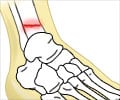
"Splints are effective for immobilization of fractured extremities in children and adolescents when placed appropriately," said lead author Joshua M. Abzug, MD, FAAP, director of pediatric orthopedics at University of Maryland Medical Center and assistant professor of orthopedics at the University of Maryland School of Medicine. "Unfortunately, many practitioners in pediatric emergency departments and urgent care centers incorrectly apply splints, potentially causing injury."
Dr. Abzug and his colleagues evaluated 225 patients younger than 18 years who came to a pediatric orthopedic clinic for an evaluation with a splint on. Patients or their parents filled out a questionnaire that asked when and where the splint was applied, the type of splint used and who applied it (e.g., orthopedic physician, emergency medicine physician, nurse practitioner).
Researchers then evaluated the splint to determine if it was the correct length and whether the elastic bandage was directly on the skin. After the splint was removed, the injured area was examined for any soft tissue complications caused by the splint, and an orthopedic physician evaluated the patient and made a diagnosis.
Results showed that 93 percent of the splints were placed improperly. The most common errors were application of the elastic bandage directly to the skin (77 percent), improper positioning (59 percent) and inappropriate splint length (52 percent).
Skin and soft tissue complications caused by splints were seen in 40 percent of patients. Furthermore, 12 percent of patients had two or more complications. The most common splint-related complication was excessive swelling, which was present in 28 percent of patients. Direct injury to the skin and soft tissue, including scrapes, blisters and ulcers, was seen in 6 percent of patients. None of the injuries required intervention other than local wound care.
Advertisement
Advertisement









